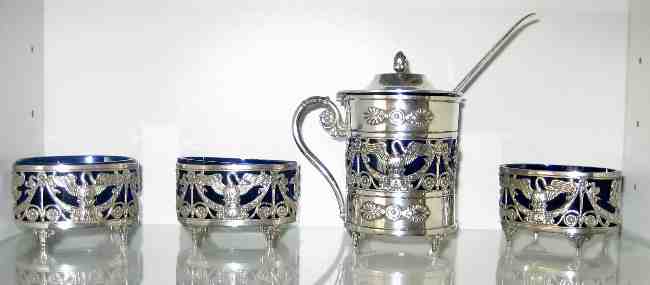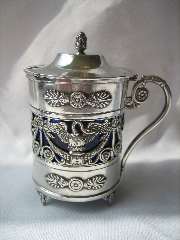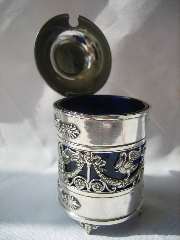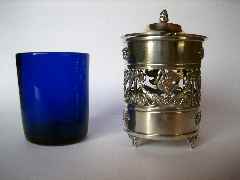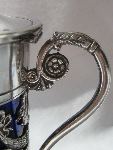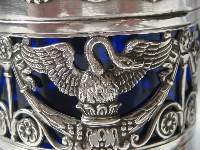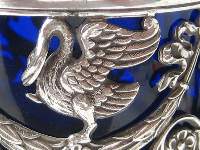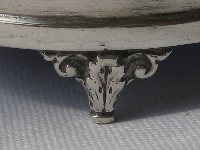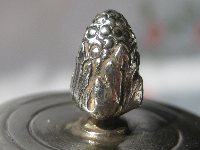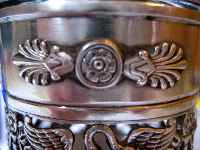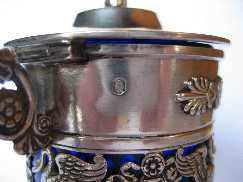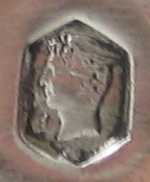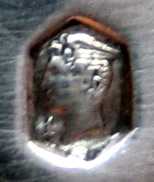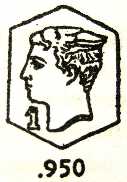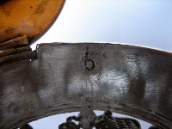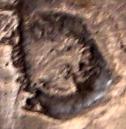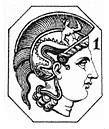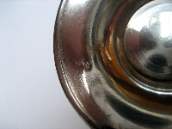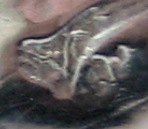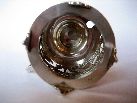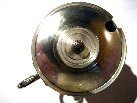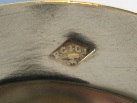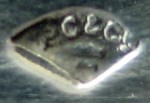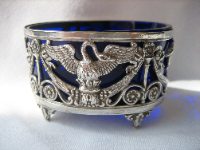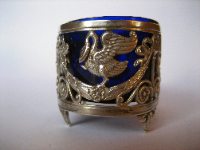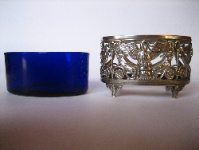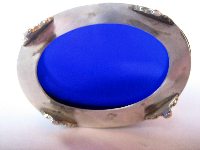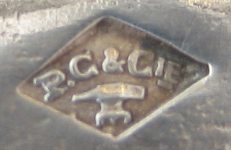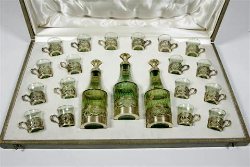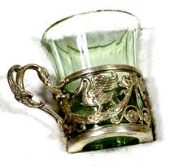by Robert
Massart
(click on photos to enlarge image)
A Silver Cruet Set - Paris 1892/1911
And a preliminary study of the workshops succeeding Paul Canaux
This beautiful Art Nouveau cruet set consists of a silver
mustard pot and three silver salt cellars. The set was
manufactured in Paris in the workshops of Paul Canaux & Company,
75 Boulevard Malesherbes, during the period 1892-1911.
The cylindrical silver mustard pot is made of a 1 mm rolled
silver sheet and is seamed to make the upright shape. The body
is divided in three sections of which the middle section is
adorned with swags and scrolls of floral motifs intertwined with
swans. The upper and lower sections are adorned with roses and
palm foliage. The mustard pot stands on four small ornamental
feet and the original cobalt blue liner is in pristine
condition. The domed hinged lid has a finial representing a
bunch of grapes. The looped handle ends in a flower and foliage.
The mustard pot stands 90 mm high with a diameter of 55 mm. The
weight of silver is a hefty 94 grams (172 grams including the
liner).
In total six marks are punched as well on the outer and
inner side of the body, as on the bottom of the body and the
outer and inner side of the hinged lid:
Mercury’s head, both on the outer body-side of the pot and
the outer side of the lid (mark introduced since 1st July 1879
for .950 silver)
Minerva’s head (partially erased) on the inside of the pot
(hallmark introduced on 10th of May 1838
Countermark (Bigorne or beak-iron)
The sponsor's mark ‘P.C Cie over an anvil’ in a lozange
punched on both the bottom and the outer side of the lid
The silver mustard pot is accompanied by three silver salt
cellars with the original cobalt blue liners. The pierced
contour is adorned with garlands, flowers and swans. The salt
cellars are raised on four ornamental feet. Dimensions are: 35
mm high, 40 mm wide and 48 mm long. The silver weight of a salt
cellar is 23 grams (60 grams including the cobalt blue glass
liner).
The sponsor’s mark ‘P.C Cie over an anvil’ in a lozenge is
punched on the bottom of the salt cellars.
Afterthought
Searching internet I traced a set of three pitchers and
eighteen liquor glasses, manufactured by Paul Canaux, showing an
identical finish with swans and palm foliage as the cruet set
described above.
TIME LINE OF SUCCESSIVE WORKSHOPS
The time line of workshops succeeding to Paul Canaux covers
a period dating from 1839 till 1936, or nearly one century. The
century was characterized by the development of several art
styles, which influenced considerably the
silversmiths and jewellers crafting, in France and abroad.
The Empire style (1800-1815)
A design movement in architecture, furniture and other
decorative arts was popularized by the designs of the
architects to the court of Napoleon Bonaparte, Pierre Léonard
Fontaine and Charles Perrier. The style was based on Greek and
Roman art.
The most renowned silversmiths of that period were Henri Auguste
(1759-1816), Jean Baptiste Claude Odiot (1763-1850) and Martin
Guillaume Biennais (1764-1843).
Restauration style (1814-1824)
A reaction against the ideas of the Revolution and the Empire
style; characterized by less decorations, yet still retaining
the taste for antiquity.
The Style Charles X (1824-1830)
Was adapted to the tastes and needs of the new Bourgeois
society.
It is a difficult and encumbered style as well in shapes as in
colors. The Charles X style is not at all discrete but
celebrates the reign of oddities (bibelots).
The Louis Philippe style (1830-1848)
Named after the reign of Louis Philippe I, king of France, it is
characterized by simplicity and very little ornamentation.
The Second Empire style or Napoleon III style (1852-1870)
A period during which "Orientalism", luxury and the taste for
flamboyance is exercised in all the fields of decorative arts
such as furniture, ceramics and silversmithing.
Emile Froment Meurice is the most renowned French silversmith of
this period.
Art Nouveau style (1890-1914)
The name derives from the Maison de l'Art Nouveau, an interior
design gallery opened in Paris in 1896. During the 1900 World's
Fair in Paris, Art Nouveau was established as the first new
decorative style of the twentieth century. Art Nouveau was in
many ways a response to the Industrial Revolution.
Art Deco style (1925-1940’s)
The name Art Deco is derived from the exhibition 'Exposition des
Arts Décoratifs', which was held in Paris in 1925.
A well known silversmith of Art Deco creations is Jean E.
Puiforcat, who joined his family's silversmithing firm in 1922.
He was mathematically inclined and transferred his creativity
into simple, yet breathtaking, Art Deco designs for silver.
BIOGRAPHIES
Joseph Mégemond & Charles Deneux
Joseph Mégemond
Maison Mégemond
(note 5)
The sponsor's mark of Joseph Mégemond, silver-plater, was struck
off on the 2nd of August 1888.
Joseph Mégemond and Charles Deneux, silver platers located 3
passage des Petites Ecuries Paris, recorded their rectangular
sponsor's mark on the 2nd of October 1863. The sponsor's mark
was struck off on the 2nd of August 1888.
Joseph Mégemond was awarded prizes during the Universal
Exhibition of 1878 (silver medal) and golden medals for the 1880
and 1887 exhibitions.
A note at the Bureau de Garantie (Assay Office) records that on
2 August 1888 Monsieur Mégemond presented himself to the
Garantie but was not able to show his sponsor’s mark at that
time.
Remark: The French internet site of the Department of Culture
indicates that Paul Canaux succeeded to Mr Mégermond,
(note 1) though several other sources point to Joseph
Mégemond (without the letter "r") as his predecessor. The latter
has a sponsor's mark "J anvil M" and Mégermond has a sponsor's
mark "J hammer M". Likely Paul Canaux based his sponsor's mark
with an anvil on that of his predecessor Mégemond and not on
that of Mégermond!
Paul Canaux
Paul Canaux & Cie
Paul Canaux, a manufacturing jeweller-silversmith, at 30 rue des
Francs-Bourgeois in Paris succeeded the silver-plater Joseph
Mégemond. He was manufacturer of silverware and table cutlery,
tea sets, centrepieces, serving dishes, etc.
Paul Canaux & Cie, still manufacturing jeweller-silversmith, now
at 30 boulevard Malesherbes, registered their sponsor's mark on
the 12th of April 1892 and moved to 127 rue de Turenne around
1889.
Their sponsor's mark was struck off on the 20th of July 1911.
A third sponsor's mark in the name of Paul Canaux,
manufacturing-silversmith at 127 rue de Turenne, was registered
on the 20th of July 1911 and struck off on the 16th of December
1930.
Maison Murat succeeded to Paul Canaux & Cie.
Maison Murat
Murat & Cie
Murat, Charles
Charles Murat started his career by manufacturing jewellery and
gold-plated wares. Murat, with his premises at 62 rue des
Archives and 1 rue des Grands Chantiers in Paris, registered his
first sponsor’s mark on the 18th of February 1851. He was
manufacturer of chains, bracelets, rings, etc.
Murat & Cie , a manufacturing-jeweller at 6 rue des Archives and
62 rue des Archives, registered their sponsor’s mark on the
3rd of July 1884 and the 20th of August 1884. Another sponsor's
mark was registered by Charles Murat at 62 rue des Archives on
the 3rd of June 1897. It is not known when these marks were
struck off.
Murat exhibited and received prizes at the Universal Exhibitions
of 1855, 1862, 1867, in Philadelphia in 1876 and in Paris in
1878. By 1900 the Maison Murat, at 62 rue des Archives, was an
important business, and a large part of its production was
silverware, cutlery and silver tableware, including tumblers,
napkin rings, cups for coffee, tea and chocolate, etc. The firm
was active until about 1900, when a number of its flatware
patterns were bought by Olier & Caron.
Eugène Caron / E Caron
The website of the French Department of Culture gives following
information for Eugène Caron:
Manufacturer jeweller with his premises at 24 rue des
Bons-Enfants, Paris. He registered his sponsor's mark "E over a
rowboat over C"
(note 2) on 23 May 1876. N° de garantie A8782. No
préfecture number.
Nevertheless I found a sponsor’s mark on internet "a rising sun
over EC over a 5 pointed star"
(note 3) for E Caron (most probably not the same
silversmith as Eugène Caron). This sponsor's mark looks more
consistent for the silversmith Caron who entered in partnership
with Olier in 1910.
Olier & Caron
Caron took the succession of Henri Soufflot, who himself
succeeded to Henri Chenailler
(note 4).
Olier & Caron registered their sponsor's mark on the 15th of
November 1910 and it was struck off on the 1st of May 1936.
Henri Chenailler
Henri Chenailler, a manufacturer silversmith at 36 rue Meslay,
Paris and later at 89 rue de Turbigo in Paris, registered his
sponsor's mark in 1867. The mark was struck off in 1884. He was
succeeded in the same house by Henri Soufflot.
Henri-Louis Chenailler
Henri-Louis Chenailler, a silversmith, had his premises at 277
rue Saint-Martin, Paris. He registered his sponsor's mark on the
3rd of January 1839. The mark was struck off at his death on 11
June 1859.
Based on the time gab between the activities of Henri-Louis
Chenailler (1839-1859) and Henri Chenailler (1867-1884) it seems
reasonable to assume that Henri Chenailler was a relative who
succeeded to Henri-Louis Chenailler.
Henri Soufflot
Henri Soufflot & Cie
Henri Soufflot, operating from 89 rue de Turbigo in Paris,
registered his sponsor's mark on the 12th of April 1884. The
sponsor's mark was struck off on the 30th of April 1910. Henri
Soufflot manufactured silverware, fine cutlery and silver
flatware.
The style of the firm was changed to Henri Soufflot & Company
and a sponsor's mark was registered on the 25th of May 1910. The
sponsor's mark was struck off on the 9th of November 1910, when
Caron took over the business.
In her article "Les entreprises de bijouterie à Paris de 1860
à 1914" Jacqueline Viruega states that it was typical for
the period 1860-1914 that Parisian jewellery and silversmith
companies were more frequently own name owners of the registered
capital than in other business sectors.
Before, to become a freeman, the young individual learned the
practice of jewellery or silversmithing during an apprenticeship
of at least 5 years. Thereafter he acted a few years as a worker
before he could, eventually, start his own business. An
apprentice worked at least 14 to 16 hours a day. In return the
employer paid a weekly salary, gave him residence, a daily
supper and bread in the morning and at noon. Practically all
addresses of the workshops mentioned above, are located in the
oldest quarter of Paris. Indeed, since the 19th century
jewellery and silversmithing houses occupy this quarter of Paris
called Marais (swamp). The location is justified by the
proximity of the Royal Palace, the Louvre Palace and the
Tuileries where the sovereigns lived (and who placed most
orders for jewellery and silver art work). Even now after 200
years these professionals continue to set up their shops in the
same area.
I have tried to satisfy my curiosity about the history of Paul
Canaux through books, internet, antique shops, and auction
houses, but I am no further ahead with all my answers.
It appears that, nonetheless Paul Canaux was a reputed
manufacturer silversmith and jeweller, little is written
concerning his activities. Incidentally, if any reader comes
across additional information regarding the life and work of
Paul Canaux, his predecessor Joseph Mégemond or his successors
Olier & Caron, I would be most grateful to hear from him or her.
ENDNOTES
1 The sponsor’s mark of J Mégermond is "J hammer M"

2 The website of the French Department of Culture shows the following sponsor's mark for Eugène
Caron:
 Address of workshop: 24 rue des Bons-Enfants
Address of workshop: 24 rue des Bons-Enfants
Date entered: 23 May 1876
N° de garantie: A8782
N° de préfecture: -
Sponsor's mark: E over a rowboat over C
3 Sponsor’s mark of E Caron

4 Note that his successors Soufflot and later Caron used the
symbols of a radiating or a rising sun and a 5 pointed star. The
same practice is seen with the sponsor's marks of Paul Canaux
and Joseph Mégemond, who both used the anvil mark.
5 pictures from the book PARIS, ses vues, Places, Monuments, Théatres, etc


BIBLIOGRAPHY
French Silver Cutlery of the 19th Century, D. Allan,
Dijon 2007, Editions Faton
Paris, Ses Vues, Places, Monuments,Théàtres, etc.,
F.G.Dumas, Paris 1889, Librairie des Imprimeries Réunies
Department of Culture France - www.cult.gouv.fr
Dictionnaire des poinçons de fabricants d’ouvrages d’or de
Paris et de la Seine 1798-1838, Catherine Aminjon-James
Beaupuis-Michèle Bilimoff, Paris 1991, Imprimerie Nationale
Dictionnaire des poinçons de fabricants d’ouvrages d’or de
Paris et de la Seine 1838-1875, Catherine Aminjon-James
Beaupuis-Michèle Bilimoff, Paris 1994, Imprimerie Nationale
Les enterprises de bijouterie à Paris de 1860 à 1914,
Jacqueline Viruega, article in "Histoire, Economie & Société"-
2006/4
Almanach du commerce de Paris, des départements de l’Empire
Français et des principales villes du monde, Année 1811, J.
de la Tynna
|
MARK
ON/OFF
|
SPONSOR'S
MARK
|
NAME
|
ADDRESS
|
MARK
ON/OFF
|
SPONSOR'S
MARK
|
NAME
|
ADDRESS
|
2-10-1863
2-8-1888
|
|
Joseph Mégemond & Charles Deneux
Silver platers
Sponsor's mark: M anvil D over &
N° de garantie: 7358
N° de préfecture: 7583
|
3 passage des Petites-Ecuries, Paris
|
.
|
.
|
.
|
.
|
2-8-1888
|
|
Joseph Mégemond
Manufacturer silversmith
Sponsor's mark: J anvil M
|
30 boulevard Malesherbes, Paris
|
26-4-1788
1814
|
|
Pierre-Benoit Lorillon
Sponsor's mark: radiating sun over PBL
|
181 rue Saint-Martin, Paris
|
9-8-1888
12-4-1892
|
|
Paul Canaux
Manufacturer jeweller-silversmith
Sponsor's mark: P anvil C
N° de garantie: B178
N° de préfecture: 10541
|
30 rue des Francs-Bourgeois, Paris
|
1814
1839
|
|
Cincinnatis Lorillon
Sponsor's mark: radiating sun over CL over a five pointed star
|
239 rue Saint-Martin, Paris
|
12-4-1892
20-7-1911
|
|
Paul Canaux & Cie
Manufacturer jeweller-silversmith
Sponsor's mark: P.C&Cie over an anvil
N° de garantie: B526
N° de préfecture: 10896
|
30 boulevard Malesherbes, Paris
|
3-1-1839
11-6-1859
|
|
Henri-Louis Chenailler
Manufacturer silversmith
Sponsor's mark: rising sun over HC over a 5 pointed star
N° de garantie: 3775
N° de préfecture: 3937
|
277 rue Saint-Martin, Paris
|
20-7-1911
16-12-1930
|
|
Paul Canaux
Manufacturer silversmith
Sponsor's mark: P anvil C
N° de garantie: C1789
N° de préfecture: 13868
|
127 rue de Turenne, Paris
|
1859
1862
|
|
Veuve Henri-Louis Chenailler
Sponsor's mark : radiating sun over VEC over 5 pointed star
|
56 rue Meslay, Paris
|
6-10-1913
22-12-1922
|
|
Paul Canaux
Manufacturer jeweller-silversmith
Sponsor's mark: P stork C
N° de garantie: C2182
N° de préfecture 14487
|
11 rue Laffitte, Paris
|
1862
1867
|
|
Antoine-Félix Desreux
Sponsor's mark: radiating sun over AD over 5 pointed star
|
56 rue Meslay, Paris
|
18-2-1851
3-7-1884
20-8-1884
3-6-1897
c.1900
|
|
Charles Murat - Murat & Cie
Maison Murat S.A.
Manufacturer jeweller
Sponsor's mark: C berry and 2 leaves M
N° de garantie: 5240;C14 (2 punches)
N° de préfecture: 5420; 11448
|
1 rue des Grands-Chantiers
62 rue des Archives, Paris
|
1867
1884
|
|
Henri Chenailler
Manufacturer silversmith
Sponsor's mark: radiating sun over HC over a 5 pointed star
|
56 rue Meslay, Paris
89 rue de Turbigo, Paris
|
.
|
. |
.
|
.
|
12-4-1884
30-4-1910
|
|
Henri Soufflot
Manufacturer jeweller
Sponsor's mark: radiating sun over HS over 5 pointed star
N° de garantie: A9671
N° de préfecture: 10016
|
89 rue de Turbigo, Paris
|
.
|
. |
.
|
.
|
25-5-1910
9-11-1910
|
|
Henri Soufflot & Cie
Manufacturer silversmith
Sponsor's mark: rising sun over HS over a five pointed star
N° de garantie : C1572
N° de préfecture : 13291
|
89 rue de Turbigo, Paris
|
1876-1910
|
|
Eugène Caron
Sponsor's mark: rising sun over EC over a 5 pointed star
|
24 rue des Bons-Enfants, Paris
|
.
|
.
|
.
|
.
|
.
|
15-11-1910
1-5-1936
|
|
Olier & Caron
Manufacturer silversmith
Sponsor's mark: rising sun over OC over a 5 pointed star
N° de garantie: C1654
N° de préfecture: 13644
|
39 rue de Turbigo, Paris
|

|

|

|
.
|
|
 ASSOCIATION OF SMALL COLLECTORS OF ANTIQUE SILVER
ASSOCIATION OF SMALL COLLECTORS OF ANTIQUE SILVER